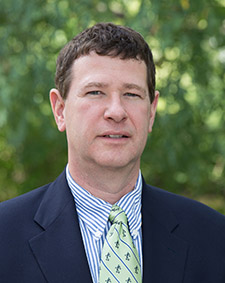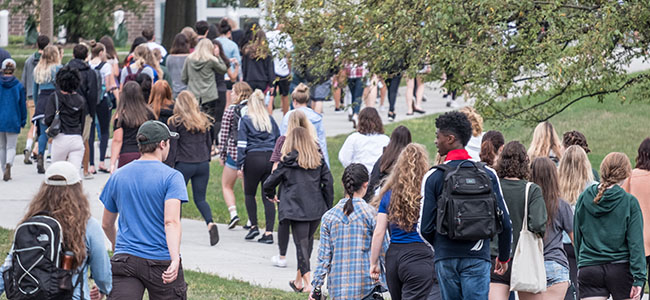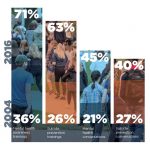 How can peer educators help address mental health on campuses?
How can peer educators help address mental health on campuses?
By Matthew Wawrzynski
Associate Professor
Department of Educational Administration
mwawrzyn@msu.edu
Of the almost 20 million students enrolled in colleges and universities across the United States, many are engaged in cocurricular experiences and serve in leadership roles. Some of these student leaders, often referred to as peer educators, can be found in residence halls as resident assistants, as advisors in academic advising and career offices or as educators in health and wellness centers. Peer educators serve and support their peers in voluntary and paid positions after being selected and receiving training specific for their positions. I like to think peer educators have become a staple on many higher education campuses because administrators value the leadership, mentoring capacities and influence of undergraduate students on their peers.
In fact, the strength of peer influence has several benefits on the outcomes of student learning, attitudes and behaviors. The unique influence college students have on each other is widely acknowledged and cited in the higher education literature (Astin, 1993; Pascarella & Terenzini, 2005; Mayhew, Bowman, Rockenbach, Seifert, Wolniak, 2016). Many studies note that undergraduate peers are the single most powerful source of influence on undergraduate student affective growth and development in college. Moreover, peer education programs continue to grow exponentially across higher education because fellow students can communicate with each other about sensitive issues, such as alcohol, drug use or sexuality when faculty or administrators cannot (Wawrzynski, LoConte, Straker, 2011).
A NATIONAL LOOK AT LEARNING

Photo courtesy of MSU Communications and Brand Strategy
Despite the common use of peer educators in virtually all sectors of higher education, little research beyond anecdotal evidence has examined the experiences of these students or the type of benefits, if any, they derive from their involvement in these roles. This was the impetus for the development of the National Peer Educator Study, which examines the experiences, training and learning outcomes of peer educators across the country.
For more than a decade, I have directed the study with a team of national researchers and Michigan State University graduate assistants. The project is funded with grant support from the BACCHUS Initiatives of NASPA (formerly The BACCHUS Network), which focuses on peer education.
As one component of the National Peer Educator Study, we have distributed a survey to peer educators at over 300 different higher education institutions where we ask questions exploring six domains of their own learning:
- Cognitive complexity (ability to develop solutions, analyze situations, apply prior experiences)
- Practical competence (effectively present programs, sense of purpose, provide feedback)
- Intrapersonal competence (recognize strengths/weaknesses, clarifying values and beliefs)
- Interpersonal competence (effectively work with others, manage conflicts, lead a group)
- Knowledge acquisition, construction, integration and application (re-evaluate previous assumptions, listen to and consider others’ viewpoints, formulate approaches and solutions)
- Humanitarianism and civic engagement (have conversations with students different from oneself, responsible for helping to improve campus community)
These domains align with three key documents that encourage intentional efforts for student learning and development in higher education:
- Learning Reconsidered (National Association for Student Personnel Administrators & American College Personnel Association, 2004)
- CAS Professional Standards for Higher Education (Council for the Advancement of Standards, 2016)
- Learning Reconsidered 2 (Keeling, 2006)
Each spring, advisors are sent customized reports about their campus peer educators who participated in the survey. These institutional reports allow advisors to benchmark learning outcomes of their peer educators to those at similar-type institutions, identify additional training areas needed among their peer educators and provide evidence on the influence of being in these leadership roles.
CHANGES WORTH NOTING
After the National Peer Educator Survey was administered for its 10th year, in fall 2013, we began examining trends in the data more closely. For example, given the recent attention in the media to mental health awareness at colleges and universities, we were interested
in learning more about the types of training peer educators were receiving. We found peer educators reported an increase in training for mental health awareness (36 percent in 2004 to 71 percent in 2016) and suicide prevention (26 percent in 2004 to 63 percent in 2016). The data also revealed dramatic increases in the number of peer educators who reported they talked with peers on their campus around mental health concerns (21 percent in 2004 compared to 45 percent in 2016) and suicide prevention (27 percent to 40 percent).
The National Peer Educator Study specifically focuses on college peer educators who work with health and wellness initiatives, but the learning outcomes are easily applicable to peer educators in other campus services and initiatives. Although the level of training has increased, these numbers are alarming and signify more must be done to address the growing concerns of mental health awareness and suicide prevention. Also noteworthy are the other means by which peer educators provide valuable health-related information about these topics to their peers, namely conducting presentations (which has declined over the years) and handing out information (which has spiked).
Higher education is faced with the growing reality that more college students are coming to campus with mental health concerns. As a result of these increases, greater numbers of colleges and universities have responded by training faculty and staff to recognize warning signs of distress in students to create safety nets of support. These campus members play an important role in these networks of support, but peer educators may also be an integral part of these supportive networks in crisis intervention and education. Although they are limited in the types of services they provide, peer educators can be prepared to direct students to the help they need.
Our data show students are already coming to peer educators to talk about their concerns and distress, which reinforces the need for colleges and universities to provide the necessary training and resources to help peer educators responsibly be part of this supportive network.
REFERENCES
Keeling, R. (2006). Learning reconsidered 2: Implementing a campus-wide focus on the student experience. Washington, D.C.: ACPA, ACUHO-I, ACUI, NACA, NACADA, NASPA, & NIRSA.
American College Personnel Association & National Association of Student Personnel Administrators (2004). Learning reconsidered: A campus-wide focus on the student experience. Washington, D.C.: National Association of Student Personnel Administrators and the American College Personnel Association.
Astin, A.W. (1993). Assessment for excellence: The philosophy and practice of assessment and evaluation in higher education. Phoenix, AZ: The Oryx Press.
Council for the Advancement of Standards (2016). The book of professional standards for higher education (9th ed.). Washington, D.C.: Author.
Mayhew, M., Bowman, N., Rockenbach, A., Seifert, T., & Wolniak, G. (2016). How college affects students: 21st century evidence that higher education works. San Francisco, CA: Jossey-Bass.
Pascarella, E. T., & Terenzini, P. T. (2005). How college affects students: A third decade of research (Vol. 2). San Francisco, CA: Jossey-Bass.
Wawrzynski, M.R., LoConte, C.L., & Straker, E.J. (2011). The National Peer Educator Study: Assessing Outcomes of Peer Educators. In L. B. Williams (Ed). New Directions for Student Services, 133, 17-27. San Francisco, CA: Jossey-Bass.
ABOUT THE STUDY
Over 4,000 students at over 300 institutions have participated in the National Peer Educator Study led by Matthew Wawrzynski, who directs the Higher, Adult and Lifelong Education (HALE) programs at MSU. Through annual surveys, the longstanding project helps participating campuses understand how peer educators—in this case, students advising peers about health and wellness issues—benefit from their role.
Participate in the study:
ow.ly/pEEw30ivGK0





